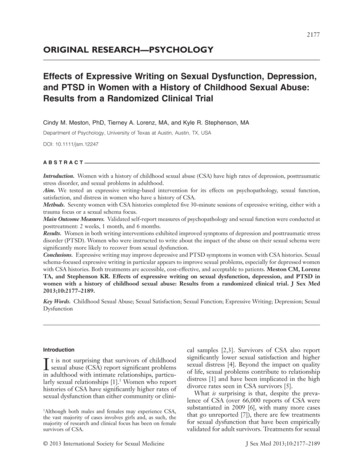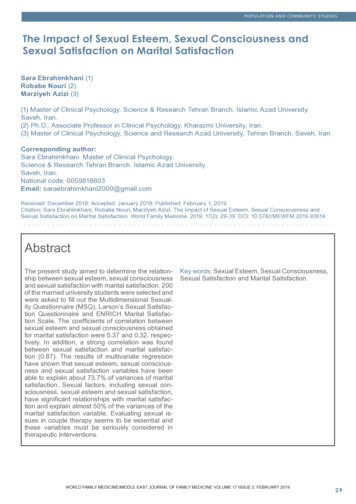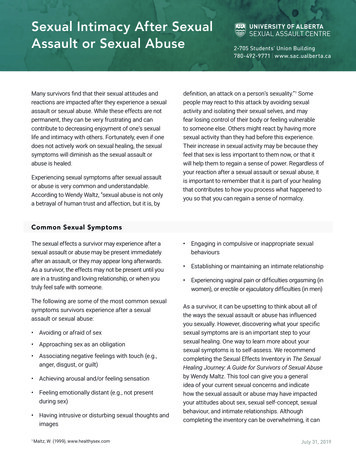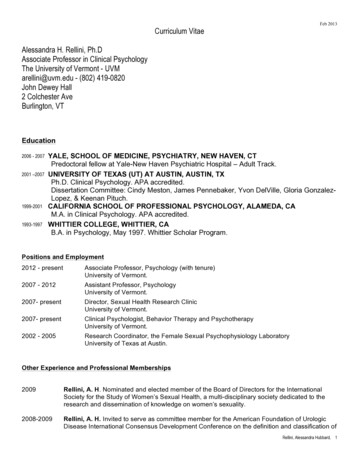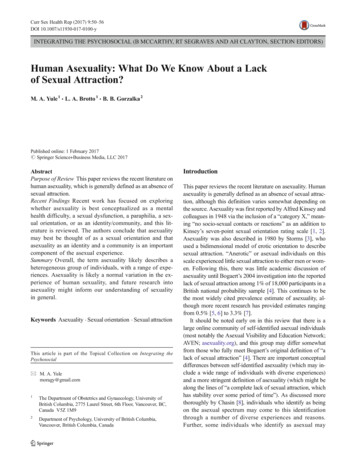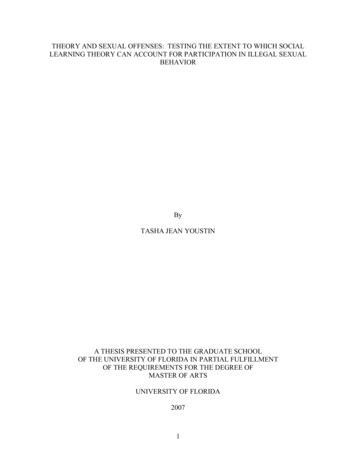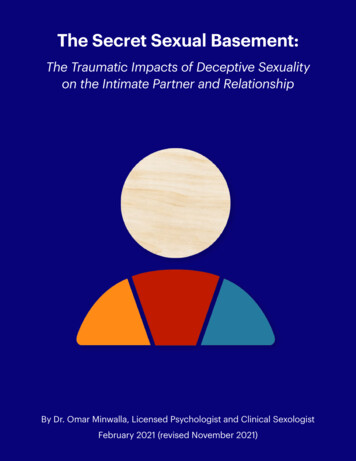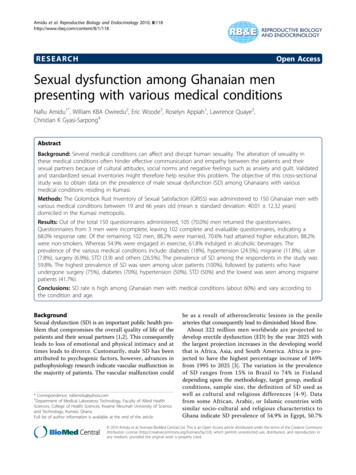
Transcription
Amidu et al. Reproductive Biology and Endocrinology 2010, en AccessSexual dysfunction among Ghanaian menpresenting with various medical conditionsNafiu Amidu1*, William KBA Owiredu2, Eric Woode3, Roselyn Appiah1, Lawrence Quaye2,Christian K Gyasi-Sarpong4AbstractBackground: Several medical conditions can affect and disrupt human sexuality. The alteration of sexuality inthese medical conditions often hinder effective communication and empathy between the patients and theirsexual partners because of cultural attitudes, social norms and negative feelings such as anxiety and guilt. Validatedand standardized sexual inventories might therefore help resolve this problem. The objective of this cross-sectionalstudy was to obtain data on the prevalence of male sexual dysfunction (SD) among Ghanaians with variousmedical conditions residing in Kumasi.Methods: The Golombok Rust Inventory of Sexual Satisfaction (GRISS) was administered to 150 Ghanaian men withvarious medical conditions between 19 and 66 years old (mean standard deviation: 40.01 12.32 years)domiciled in the Kumasi metropolis.Results: Out of the total 150 questionnaires administered, 105 (70.0%) men returned the questionnaires.Questionnaires from 3 men were incomplete, leaving 102 complete and evaluable questionnaires, indicating a68.0% response rate. Of the remaining 102 men, 88.2% were married, 70.6% had attained higher education, 88.2%were non-smokers. Whereas 54.9% were engaged in exercise, 61.8% indulged in alcoholic beverages. Theprevalence of the various medical conditions include: diabetes (18%), hypertension (24.5%), migraine (11.8%), ulcer(7.8%), surgery (6.9%), STD (3.9) and others (26.5%). The prevalence of SD among the respondents in the study was59.8%. The highest prevalence of SD was seen among ulcer patients (100%), followed by patients who haveundergone surgery (75%), diabetes (70%), hypertension (50%), STD (50%) and the lowest was seen among migrainepatients (41.7%).Conclusions: SD rate is high among Ghanaian men with medical conditions (about 60%) and vary according tothe condition and age.BackgroundSexual dysfunction (SD) is an important public health problem that compromises the overall quality of life of thepatients and their sexual partners [1,2]. This consequentlyleads to loss of emotional and physical intimacy and attimes leads to divorce. Customarily, male SD has beenattributed to psychogenic factors, however, advances inpathophysiology research indicate vascular malfunction inthe majority of patients. The vascular malfunction could* Correspondence: nafamidu@yahoo.com1Department of Medical Laboratory Technology, Faculty of Allied HealthSciences, College of Health Sciences, Kwame Nkrumah University of Scienceand Technology, Kumasi, GhanaFull list of author information is available at the end of the articlebe as a result of atherosclerotic lesions in the penilearteries that consequently lead to diminished blood flow.About 322 million men worldwide are projected todevelop erectile dysfunction (ED) by the year 2025 withthe largest projection increases in the developing worldthat is Africa, Asia, and South America. Africa is projected to have the highest percentage increase of 169%from 1995 to 2025 [3]. The variation in the prevalenceof SD ranges from 15% in Brazil to 74% in Finlanddepending upon the methodology, target group, medicalconditions, sample size, the definition of SD used aswell as cultural and religious differences [4-9]. Datafrom some African, Arabic, or Islamic countries withsimilar socio-cultural and religious characteristics toGhana indicate SD prevalence of 54.9% in Egypt, 50.7% 2010 Amidu et al; licensee BioMed Central Ltd. This is an Open Access article distributed under the terms of the Creative CommonsAttribution License (http://creativecommons.org/licenses/by/2.0), which permits unrestricted use, distribution, and reproduction inany medium, provided the original work is properly cited.
Amidu et al. Reproductive Biology and Endocrinology 2010, 8:118http://www.rbej.com/content/8/1/118Page 2 of 8in Nigeria and 64.3% in Turkey [10]. Previous study byour group among the general Ghanaian populace indicates 66% prevalence of SD [11].Earlier studies have demonstrated an associationbetween SD and medical conditions such as vascular disease [12,13] and cardiovascular risk factors [13]. SD couldbe a symptom and/or a marker of vascular disease progression [14]. Hypertension is one of the common medicalconditions [15], together with diabetes mellitus, migraine,ulcer, surgery, sexual transmitted diseases and dyslipidaemia that could modify the sexual function of an individual.Even though, most of these are widely accepted as risk factors for SD, available data are controversial and indicatethat this relationship is not well established. For example,the reports of Virag et al.,[16], Shabsigh et al., [17] andJaffe et al.,[18] indicated that hypertension was not anindependent predictor of vasculogenic ED. The objectiveof this cross-sectional study was to obtain data on the prevalence of male SD among Ghanaian men presenting withvarious medical conditions residing in Kumasi. To ourknowledge, this is the first study of SD conducted amongthis population in Ghana.premature ejaculation, infrequency, non-communication,non-sensuality, avoidance and dissatisfaction. Responsesare summed up to give a total raw score (range 28-140).The total score and subscale scores are transformed usinga standard nine point scale, with high scores indicatinggreater problems. Scores of five or more are considered toindicate SD. The GRISS was chosen because it is standardized, easy to administer and score, relatively unobtrusiveand substantially inexpensive. The reliability of the overallscales has been found to be 0.94 for men, and that of thesubscales on average 0.74 (ranging between 0.61 and 0.83).Validity has been demonstrated under a variety of circumstances [19-21].MethodsResultsOut of the total 150 questionnaires administered, 105(70.0%) men returned the questionnaires. The questionnaires from 3 men were incomplete, leaving 102complete and evaluable questionnaires, indicating a68.0% response rate. The age range for the respondingmen was 19 to 66 years with a mean standard deviation of the age being 40.01 12.32 years. Majority ofthe men who responded were married (88.2%), hadattained higher education (70.6%), consumed alcoholicbeverages (61.8%) and are non-smokers (88.2%). Abouthalf of the study population were engaged in exercise(54.9%). The respondents suffered from the followingmedical conditions: diabetes (18%), hypertension(24.5%), migraine (11.8%), ulcer (7.8%), surgery (6.9%),STD (3.9%) and others (26.5%). When the respondentswere stratified based on sexual function, those with SDwere older, married, had a longer duration of marriageand performed little or no exercise as compared tothose without SD as shown in Table 1. The overallGRISS score and the score for each subscale were significantly higher in responding men with SD as compared to without SD (Table 2).The prevalence of SD among the respondents in thestudy was 59.8% (61 out of 102) as shown in Figure 1. Themost prevalent areas of difficulty were impotence (76 outof 102, 74.5%), infrequency (74 out of 102, 72.5%), premature ejaculation (67 out of 102, 65.7%), dissatisfaction(66 out of 102, 64.7%), non-communication (63 out of102, 61.8%), non-sensuality (61 out of 102, 59.8%), avoidance (60 out of 102, 58.8%) (Figure 1).SubjectsThis epidemiological cross-sectional study was conducted among subjects with various medical conditionsin the Kumasi metropolis, Ghana between January andApril 2010. All the participants were sexually activeGhanaians, aged 19 years and above, who had maintained a stable heterosexual relationship for at least2 years before enrollment in the study. A stable relationship was defined as one in which the man maintainssexual relations regardless of marital status. A randommethod was used to administer the questionnaires to atotal of 150 heterosexual men with various medical conditions within the Kumasi Metropolis. Ulcer as used inthis study includes any form of stomach ulcer and surgery involved any form of surgery. Participation of therespondents was voluntary and informed consent wasobtained from each participant. The study was approvedby the Committee on Human Research, Publication andEthics of the School of Medical Science and the KomfoAnokye Teaching Hospital, Kumasi.QuestionnairesSexual response was measured by the Golombok RustInventory of Sexual Satisfaction (GRISS) questionnaire.The GRISS has 28 items on a single sheet and it is usedfor assessing the existence and severity of sexual problems.All the 28 questions are answered on a five-point scalefrom “always”, through “usually”, “sometimes”, and “hardlyever”, to “never”. It gives overall SD scores and also gives aprofile for the men on 7 subscales, comprising impotence,Statistical analysisThe data were presented as mean standard deviationor percentages. Continuous data were analyzed usingunpaired t-tests whilst categorical variables were analyzed using Fischer’s exact tests. In all statistical tests, avalue of p 0.05 was considered significant. All analyseswere performed using SigmaPlot for Windows, Version11.0, (Systat Software, Inc. Erkrath, Germany) [22].
Amidu et al. Reproductive Biology and Endocrinology 2010, 8:118http://www.rbej.com/content/8/1/118Page 3 of 8Table 1 General characteristic of the studied population stratified by SDVariablesTotal (102)Without SD (41)With SD (61)Age (yrs)42.01 12.3237.32 11.2645.16 12.080.001390(88.2)33(80.5)57(93.4)0.046512.99 9.810.29 8.514.61 10.20.041372(70.6)29(70.7)43(70.5)0.9792Married (%)Duration of marriage (yrs)High education (%)P valueCigarette smoke per years090(88.2)35(85.4)55(90.2)0.4609 109(8.8)5(12.2)4(6.6)0.325010-20 203(2.9)0(0.0)1(2.4)0(0.0)2(3.3)0(0.0)0.8056No of big bottle of alcohol taken per week039(38.2)14(34.1)25(40.9)0.4860 6(9.8)0.9894 3)32(52.5)23(37.7)0.03850.38491-5 times9(8.8)4(9.8)5(8.2)0.7854 5 times5(4.9)4(9.8)1(1.6)0.0627No of exercise per week0weekends onlyMedical tinuous data are presented as mean standard deviation and categorical data presented as proportion. Continuous data were compared using unpairedt-test and categorical data compared using chi square analysis.Table 2 Raw score as well as stannine score for the various GRISS subscales stratified by SDVariablesTotal (n 102)Without SD (n 41)With SD (n 61)P valueRaw score for the various GRISS subscalesImpotence11.5 2.410.1 2.312.5 1.9infrequency6.1 1.25.6 1.26.5 1.10.00160.0201Non-communicationDissatisfaction5.6 1.511.2 2.35.0 1.69.7 2.36.0 1.412.2 1.60.04740.0008Avoidance8.2 3.26.9 2.79.4 3.30.0229Non-sensuality11.7 2.310.6 2.512.4 1.90.0195Premature ejaculation9.6 2.58.1 2.110.6 2.20.0009Stannine score for the various GRISS subscalesImpotence5.0 1.74.0 1.75.6 1.4infrequency5.0 1.74.2 1.75.4 1.60.0224Non-communicationDissatisfaction5.2 1.95.1 1.94.4 2.03.9 1.95.7 1.75.1 1.40.02940.0005Avoidance5.0 2.04.1 1.95.5 1.90.0177Non-sensuality4.9 1.84.3 1.85.4 1.60.0601Premature ejaculation5.0 1.93.9 1.65.8 1.60.0010Results are presented as mean Standard Deviation, SD SD.0.0019
Amidu et al. Reproductive Biology and Endocrinology 2010, 8:118http://www.rbej.com/content/8/1/118Page 4 of 8Figure 1 Scores of sexual dysfunction in 102 studied patients according to GRISS questionnaire. Graph shows the distribution of scores(from 1 to 9 on the x- axis) for each GRISS subscale, with the number of patients (y-axis) above each score. Normal scores range from 1-4 andabnormal scores are 5-9.The likelihood of being sexually active declined steadily with age. When the study population was stratifiedbased on age, individuals with difficulties with SD,impotence, non-communication and infrequency gave asignificant trend with age using Chi square for trendanalysis as indicated in Table 3. The proportion of individuals with severe difficulties did not give any significant trend with age (Table 3).As shown in Table 4, whereas the highest prevalence ofindividuals with difficulties with SD (100.0%), impotence(100.0%), infrequency (88.9%), non-communication(100.0%), dissatisfaction (88.9%) and avoidance (88.9%)were seen in ulcer patients, the highest prevalence ofnon-sensuality (70.0%) and premature ejaculation (80.0%)were seen in diabetics. However, the lowest prevalence ofSD (41.7%), non-communication (41.7%) and avoidance(25.0%) were seen in individuals with migraine, the lowest prevalence of impotence (50.0%), non-sensuality(50.0%) and premature ejaculation (50.0%) were seenamong individuals with STD and that of infrequency(63.6%) and dissatisfaction (59.1%) were seen amonghypertensive patients (Table 4).Table 3 Prevalence of SD stratified by age among the studied populationVariablesnAge (years)18-2223-2728-32651833-3713Difficulties (%)*P value38-4243-47 .646.146.153.873.50.1383Non-sensualityPremature 0.08790.4795Premature ejaculation0.00.022.27.715.40.05.90.4247Severe difficulties(%)***Score of 5-9 and **Score of 8 or 9.
Amidu et al. Reproductive Biology and Endocrinology 2010, 8:118http://www.rbej.com/content/8/1/118Page 5 of 8Table 4 Prevalence of SD stratified by age among the studied cerSurgerySTDOthers20221298427Difficulties .966.762.562.525.050.055.648.1Premature Ejaculation80.059.175.066.762.550.059.3Severe difficulties mature Ejaculation0.09.18.311.112.525.014.8*Score of 5-9 and **Score of 8 or 9.Generally, the proportion of individuals with severedifficulties with SD as well as its subscale was highestamong individual with ulcer followed by diabetes andhypertension. The lowest prevalence was however seenamong individuals with migraine followed by those whohave undergone surgery and STD (Table 4).From Table 5, age correlated positively with duration ofmarriage, SD, infrequency, non-communication, and dissatisfaction. Socio-demographic characteristics (i.e. durationof marriage, education, smoking, alcohol and exercise) didnot give any significant association with SD as well as itssubscales. However, SD correlated positively with mediumto large size effect with its subscales and the subscales alsogenerally correlated positively with each other with smallto medium size effect as shown in Table 5.DiscussionComprehensive reviews of sexuality, psychopathologyand epidemiological literature suggest that sexual problems occur frequently [23] and despite increasingdemand for clinical services and the potential impact ofdisorders of SD on interpersonal relationships andTable 5 Pearson product moment correlation coefficient between SD including the 7 subscales of the GRISS (N 102)VariablesDURAge0.90***Duration (DUR)Educational level (EDU)Smoking (SMK)Alcohol consumption(ALC)Exercise (EXR)SD (SD)Impotence (IMP)Infrequency (IFQ)Non-communication (NC)Dissatisfaction (DISS)Avoidance (AVD)Non-sensuality 0.100.16*0.18*0.110.38***0.19**Correlation is significant at the 0.05 level (2-tailed), **Correlation is significant at the 0.01 level (2- tailed),***Correlation is significant at the 0.001level (2-tailed).Boldface r Pearson product moment correlation coefficient with a medium size (0.30 r 0.50) effect: boldface and underline r Pearson product momentcorrelation coefficient with a large size(r 0.50) effect, PE Premature ejaculation.
Amidu et al. Reproductive Biology and Endocrinology 2010, 8:118http://www.rbej.com/content/8/1/118quality of life [24,25], epidemiologic data are relativelyscanty.SD is said to be common among men of all ages with aprevalence that varies from 15% to 74% depending uponthe methodology, target group, sample size, and the definition of SD used [4-9]. Besides, the influence of theunderlying medical conditions as well as cultural, religious and perceptual differences on SD is not known.Whereas the observed prevalence rate of 59.8% from thiscohort is in agreement with available data on prevalencerange of SD (i.e. 15% to 74%), it is slightly higher thandata from African countries with similar socioculturaland religious characteristics (i.e. 54.9% in Egypt, and50.7% in Nigeria (Pfizer)). This prevalence rate is however close to the 64.3% prevalence rate from Turkey [10]but lower than the 66% prevalence rate reported earlieramong the general male populace from the same city inGhana by Amidu et al.,[11].These variations could be largely due to difference inmethodology, sample size, definition of SD, inherent standard and belief of an individual, most importantly, underlying medical conditions and perceptual differences.Ghanaians in this part of the country are known to perceive an intravaginal ejaculatory latency of 7-25 min asbeing normal, with about 75% perceiving adequate intravaginal ejaculatory latency time above what sex therapistsperceived as being adequate (i.e. 3-7 min). All these arealso modified by the type of formal and informal educationreceived from the society (Amidu et al., under review).Men with SD in this study were significantly older,married with longer duration of marriage and are mostlikely not to engage in any exercise when compared tomales without SD. Laumann et al.,[4] in a study on SD inthe United States reported that older men are more likelyto have trouble maintaining or achieving an erection aswell as to lack an interest in sex and attributed it to thephysiological changes associated with the aging process.Likewise, data from the Massachusetts Male Aging Study(MMAS) also showed that 34.8% of men aged 40 to70 years had moderate to complete ED which wasstrongly related to age and health status [12]. Frank et al.,[26] also identified SD among couples believed to have astable relationship with 7% of men reporting difficultiesin achieving and 9% in maintaining an erection.Advocates of exercise claim that physical activity mayenhance sexual performance and sexual pleasure [27,28].Physical endurance, muscle tone and body compositionall improve sexual functioning [27] and according to literature, sedentary men could significantly lower theirrisk of SD by burning at least 200 calories per day(equal to fast-walking for about 2 miles) [28]. Bacon etal.,[8] in a research to check which lifestyle factorsaffected the risk of SD observed that, men over 50 yearswho kept physically active had a 30% lower risk of SDPage 6 of 8compared with inactive men. The findings of this studyare consistent with that of Bacon et al which emphasized the role of age and lack of physical inactivity inthe development of SD and the existence of SD amongmarried men.A further observation of a high prevalence of SD(79.4%) in men 48 years with impotence (88.2%) andnon-communication (73.5%) being the subscale areas ofdifficulty agrees with previous studies [4,8,12]. Furlow[29] defined impotence as the persistent failure todevelop erections of sufficient rigidity for penetrative sexual intercourse and further reported it as being stronglyrelated to age, with an estimated prevalence of 2% at age40 years which rises to 25 to 30% by the age of 65. Thehigh prevalence of impotence observed in this studyshows that impotence is an inherent public health problem which will need rapt medical attention consideringthe fact that a high percentage of males with this disorderwill most likely not communicate about it thereby affecting interactions with family and associates. Impotenceshowed positive correlations with all the other subscalesof GRISS, correlating with avoidance and premature ejaculation to a medium size effect depicting a likelihood ofavoidance of sexual activities in males found in thisgroup. This finding is in agreement with the study of Tsitouras et al.,[30], who reported a progressive decline inthe frequency of sexual intercourse with advancing agewhen men between the ages of 60 and 79 were examinedin the Baltimore Aging Study.Diseases may greatly alter the sexuality of an individualand many systemic diseases reduce testosterone leadingto a decrease in libido [31]. Enzlin et al.,[32] in a studyon the prevalence and predictors of SD in patients withtype 1 diabetes reported a SD prevalence rate of 22% indiabetic males and 40.5% in males with diabetic complications. Twenty percent (20%) of diabetic males in thisstudy had severe difficulties with SD which compareswell with the findings of Enzlin et al.,[32] whilst 70% haddifficulties with SD, a prevalence rate which is higherthan that reported in available literature. McCullochet al.,[33] in a survey of diabetic males, aged 20 to 59years reported an impotence prevalence rate of 35% andFurlow [29] estimated an impotence prevalence rate of35 to 50% in diabetic men. The impotence prevalencerate (5%) in diabetic males with severe difficulties islower compared to observed rates in the studies of Furlow [29] and McCulloch et al.,[33] whilst the impotenceprevalence rate of 75% estimated in diabetic males withdifficulties in SD is higher than reported in availableliterature.Several reports have indicated that 2.4 to 58% ofhypertensive males experience one or more symptomsof SD of varying degrees of severity [34,35]. Fifty percent(50%) of hypertensive males had difficulties with SD and
Amidu et al. Reproductive Biology and Endocrinology 2010, 8:118http://www.rbej.com/content/8/1/1184.5% had severe difficulties with SD which agrees withprevalence rates quoted in available literature. Jensenet al.,[36] in their study on the prevalence and etiologyof impotence in male hypertensive outpatients reporteda prevalence rate of 27%. An impotence prevalence rateof 68.2% and 13.6% was estimated in male hypertensiveswith difficulties and severe difficulties in SD respectively.Higher sexual desire inventory scores have beenreported in subjects with migraine [37,38]. Intriguingly,the least prevalence of difficulties with SD (41.7%), noncommunication (41.7%) and avoidance of sexual activity(25.0%) was observed in males with migraine in agreement with previous studies. Ironically, the prevalence ofimpotence in males with migraine was 75% revealingthe existence of sexual disorders in migraineurs contraryto reports of increases in sexual desire and this findingis in agreement with the study of [39] who reported thatheadache contributes to less sexual activity.The prevalence of SD in males with ulcer, surgery andsexual transmitted disease (STD) was 100%, 75% and50% respectively with the corresponding impotence prevalence rates of 100%, 87.5% and 50% respectively. SDhas been reported in patients who have undergone surgery with surgical procedure being independently associated with current sexual activity [40,41]. Hendren etal.,[40] further reported impotence and partial impotence prevalence rates of 32% and 52% respectively inmales who underwent surgery for rectal cancer. Filibertiet al.,[42] attributed impotency as a consequence of rectal cancer to parasympathetic nerve injury. Fass et al.,[43] reported a self-reported SD prevalence rate of43.3% in patients with functional gastrointestinal (GI)disorders with decreased sexual drive (36.2%) being thecommon symptom in males and further found SD to bepositively associated with perceived GI symptom severity. Ulcer patients in this study had the highest prevalence of SD and a high prevalence for five out of theseven subscale disorders. The reason for the highest prevalence of SD among patients with ulcer is not readilyknown from this study, thus further studies are neededto elucidate the mechanism.The observation of significant positive correlationsbetween impotence and the other subscales of GRISS inthis study shows the likelihood of co-existence of theother subscales in varying degrees thereby affectingquality of life and relationship between spouses. Someof the limitations of this study include the fact that thestudy was based on volunteers, includes only male andself-reported data on socio-demographic information aswell as the various medical conditions.ConclusionsSD rate is high among Ghanaian men with medical conditions (about 60%) and vary according to the conditionPage 7 of 8and age. The highest prevalence of SD was seen amongulcer patients (100%), followed by patients who haveundergone surgery (75%), diabetes (70%), hypertension(50%), STD (50%) and the lowest is seen amongmigraine patients (41.7%).Author details1Department of Medical Laboratory Technology, Faculty of Allied HealthSciences, College of Health Sciences, Kwame Nkrumah University of Scienceand Technology, Kumasi, Ghana. 2Department of Molecular Medicine, Schoolof Medical Sciences, College of Health Sciences, Kwame Nkrumah Universityof Science and Technology, Kumasi, Ghana. 3Department of Pharmacology,Faculty of Pharmacy and Pharmaceutical Science, College of Health Sciences,Kwame Nkrumah University of Science and Technology, Kumasi, Ghana.4Department of Surgery, (Urology Unit) Komfo Anokye Teaching Hospital/College of Health Sciences, Kwame Nkrumah University of Science andTechnology, Kumasi, Ghana.Authors’ contributionsNA, WKBAO and EW developed the concept and designed the study. NA,WKBAO, EW, RA, LQ and CKG-S administered the questionnaire, analysedand interpreted the data. NA, RA, LQ, and CKG-S drafted the manuscript. NA,WKBAO, EW, LQ, RA and CKG-S revised the manuscript for intellectualcontent. All authors read and approved the final manuscript.Competing interestsThe authors declare that they have no competing interests.Received: 22 September 2010 Accepted: 13 October 2010Published: 13 October 2010References1. Althof SE: Quality of life and erectile dysfunction. Urology 2002,59(6):803-810.2. Wagner G, Fugl-Meyer KS, Fugl-Meyer AR: Impact of erectile dysfunctionon quality of life: patient and partner perspectives. Int J Impot Res 2000,12(Suppl 4):S144-146.3. Ayta IA, McKinlay JB, Krane RJ: The likely worldwide increase in erectiledysfunction between 1995 and 2025 and some possible policyconsequences. BJU Int 1999, 84(1):50-56.4. Laumann EO, Paik A, Rosen RC: Sexual dysfunction in the United States:prevalence and predictors. JAMA 1999, 281(6):537-544.5. Rosen RC, Fisher WA, Eardley I, Niederberger C, Nadel A, Sand M: Themultinational Men’s Attitudes to Life Events and Sexuality (MALES)study: I. Prevalence of erectile dysfunction and related health concernsin the general population. Curr Med Res Opin 2004, 20(5):607-617.6. Shiri R, Koskimaki J, Hakkinen J, Tammela TL, Huhtala H, Hakama M,Auvinen A: Effects of age, comorbidity and lifestyle factors on erectilefunction: Tampere Ageing Male Urological Study (TAMUS). Eur Urol 2004,45(5):628-633.7. Nicolosi A, Moreira ED Jr, Shirai M, Bin Mohd Tambi MI, Glasser DB:Epidemiology of erectile dysfunction in four countries: cross-nationalstudy of the prevalence and correlates of erectile dysfunction. Urology2003, 61(1):201-206.8. Bacon CG, Mittleman MA, Kawachi I, Giovannucci E, Glasser DB, Rimm EB:Sexual function in men older than 50 years of age: results from thehealth professionals follow-up study. Ann Intern Med 2003, 139(3):161-168.9. Johannes CB, Araujo AB, Feldman HA, Derby CA, Kleinman KP, McKinlay JB:Incidence of erectile dysfunction in men 40 to 69 years old: longitudinalresults from the Massachusetts male aging study. J Urol 2000,163(2):460-463.10. Pfizer Inc: Data on file. New York, NY.11. Amidu N, Owiredu WKBA, Woode E, Addai-Mensah O, Gyasi-Sarpong KC,Alhassan A: Prevalence of male sexual dysfunction among Ghanaianpopulace: myth or reality? Int J Impot Res 2010.12. Feldman HA, Goldstein I, Hatzichristou DG, Krane RJ, McKinlay JB:Impotence and its medical and psychosocial correlates: results of theMassachusetts Male Aging Study. J Urol 1994, 151(1):54-61.
Amidu et al. Reproductive Biology and Endocrinology 2010, 8:118http://www.rbej.com/content/8/1/11813. Martin-Morales A, Sanchez-Cruz JJ, Saenz de Tejada I, Rodriguez-Vela L,Jimenez-Cruz JF, Burgos-Rodriguez R: Prevalence and independent riskfactors for erec
59.8%. The highest prevalence of SD was seen among ulcer patients (100%), followed by patients who have undergone surgery (75%), diabetes (70%), hypertension (50%), STD (50%) and the lowest was seen among migraine patients (41.7%). Conclusions: SD rate is high among Ghanaian men with medical conditions (about 60%) and vary according to
